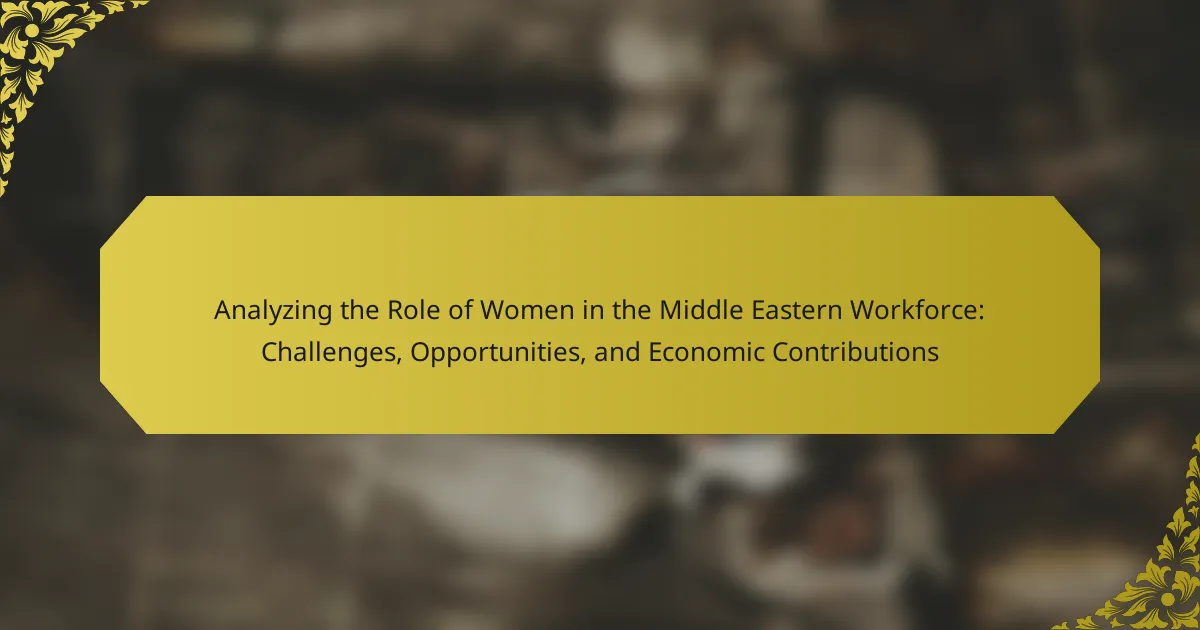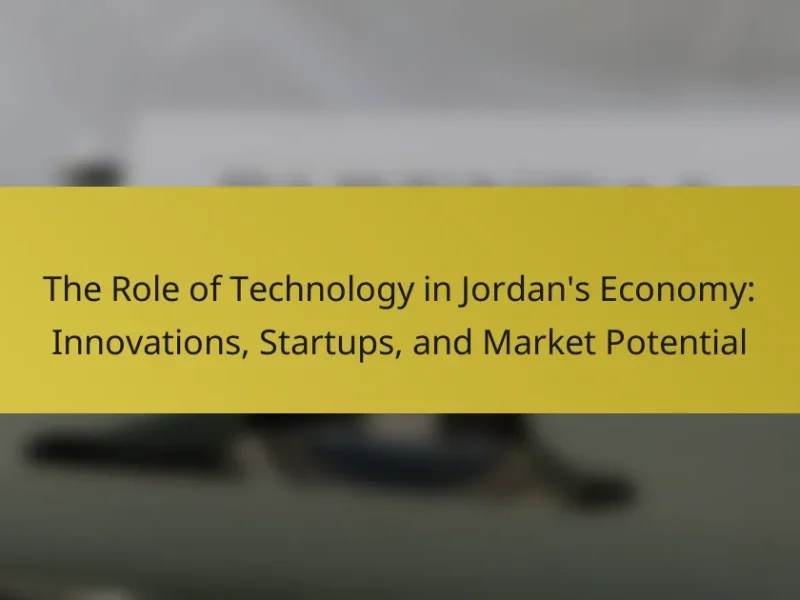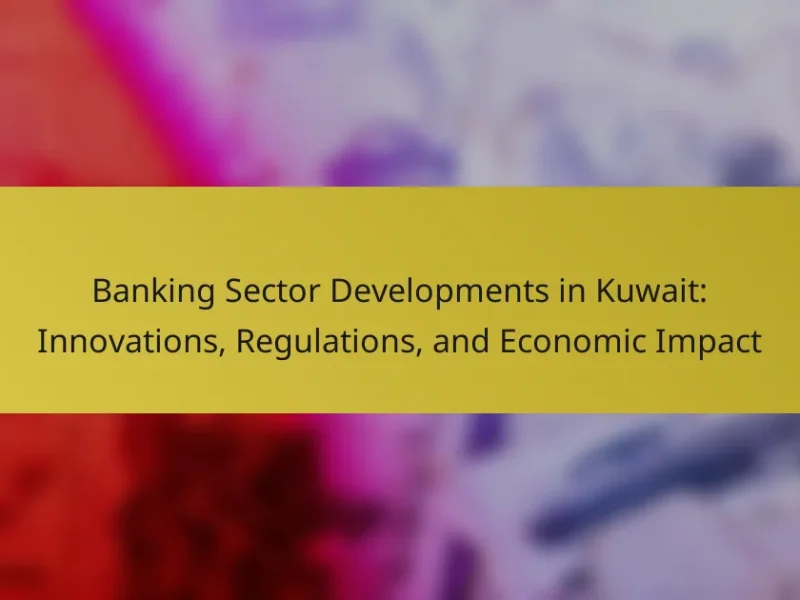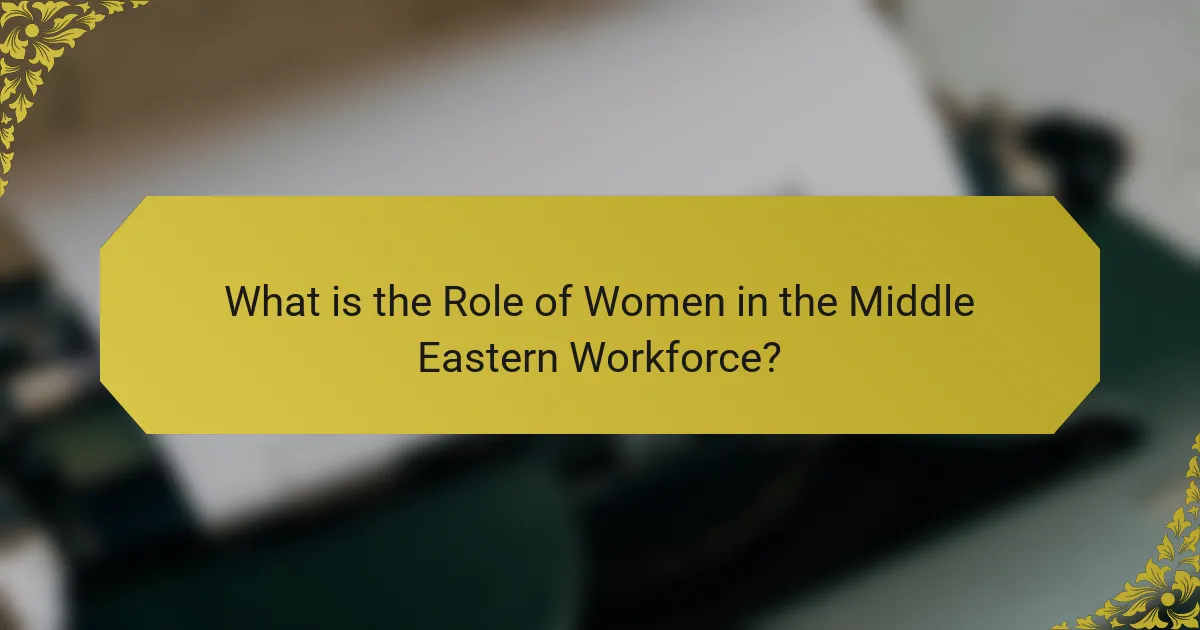
What is the Role of Women in the Middle Eastern Workforce?
Women play a significant role in the Middle Eastern workforce. Their participation has been increasing in various sectors. In countries like the UAE and Saudi Arabia, women are entering fields such as healthcare, education, and technology. As of 2021, women’s labor force participation in the UAE reached 52%. This shift is driven by government initiatives promoting gender equality. However, challenges remain, including cultural barriers and limited access to leadership roles. Despite these obstacles, women contribute substantially to economic growth. Their involvement is crucial for diversifying economies in the region.
How has the participation of women in the workforce evolved over time?
The participation of women in the workforce has significantly increased over time. In the early 20th century, women’s workforce participation was minimal, often limited to domestic roles. By the 1970s, this began to change, with more women entering various professions. In the 21st century, global trends show that women’s participation in the workforce has reached approximately 47%. In the Middle East, women’s labor force participation has also grown, though it remains lower than the global average. For example, in 2020, women’s participation in the workforce in Saudi Arabia was around 33%, reflecting substantial progress from previous decades. Factors such as education, government policies, and economic necessity have contributed to this evolution.
What historical factors have influenced women’s workforce participation in the Middle East?
Historical factors influencing women’s workforce participation in the Middle East include colonialism, economic changes, and cultural shifts. Colonial powers often disrupted traditional roles, leading to new opportunities for women in some regions. Economic development, especially in oil-rich countries, created demand for female labor. Additionally, educational reforms increased women’s access to education, enabling them to enter the workforce. Social movements advocating for gender equality also played a significant role. These factors collectively shaped the evolving landscape of women’s employment in the region.
How do cultural norms impact women’s roles in the workforce?
Cultural norms significantly impact women’s roles in the workforce. In many Middle Eastern societies, traditional views often prioritize family and domestic responsibilities for women. This can limit their participation in the labor market. For instance, societal expectations may discourage women from pursuing careers. Additionally, workplace policies may not support flexible working arrangements, further hindering women’s employment opportunities. Research indicates that in countries like Saudi Arabia, recent reforms aim to improve women’s workforce participation. However, cultural resistance remains a barrier to full integration. A 2020 report by the World Bank highlighted that only 22% of women in the Middle East participate in the labor force. This statistic underscores the ongoing influence of cultural norms on women’s employment.
What are the key challenges faced by women in the Middle Eastern workforce?
Women in the Middle Eastern workforce face several key challenges. One significant challenge is limited access to leadership positions. According to the World Economic Forum, women hold only 12% of senior roles in the region. Cultural norms also restrict women’s participation in certain sectors. Many societies prioritize traditional gender roles, impacting women’s career choices. Additionally, legal barriers exist in some countries regarding employment rights. For instance, laws may limit women’s ability to work in specific industries. Another challenge is the lack of support for work-life balance. Many women struggle to find flexible working arrangements. This often leads to high dropout rates from the workforce. Overall, these challenges hinder women’s economic contributions and professional growth in the region.
What legal barriers exist that hinder women’s employment opportunities?
Legal barriers that hinder women’s employment opportunities include restrictive labor laws and regulations. In many Middle Eastern countries, laws limit women’s ability to work in certain sectors. For example, some nations prohibit women from working in specific industries deemed unsuitable. Additionally, legal guardianship laws often require women to obtain permission from male guardians to work. This can significantly restrict their employment choices. Furthermore, inadequate maternity leave policies may discourage employers from hiring women. These barriers contribute to a lower female labor participation rate, which was 20% in the Gulf Cooperation Council countries as of 2021.
How do societal expectations affect women’s career choices?
Societal expectations significantly influence women’s career choices by shaping their perceived roles and opportunities. In many cultures, traditional norms prioritize domestic responsibilities over professional aspirations for women. This often leads to self-limiting beliefs about their capabilities in the workforce. According to a 2020 report by McKinsey & Company, women in the Middle East face unique barriers due to societal pressures, resulting in lower workforce participation rates. The report highlights that only 22% of women in the region are part of the labor force, compared to 70% for men. Furthermore, women often encounter expectations to balance work and family, which can deter them from pursuing demanding careers. These societal norms create a challenging environment for women seeking to advance professionally.
What opportunities are available for women in the Middle Eastern workforce?
Women in the Middle Eastern workforce have diverse opportunities across various sectors. These sectors include education, healthcare, technology, and entrepreneurship. In recent years, many countries have implemented policies to promote gender equality in the workplace. For instance, Saudi Arabia has introduced reforms allowing women to drive and work in previously restricted fields. The World Bank reports that women’s labor force participation in the region is gradually increasing. Additionally, initiatives like female leadership programs and mentorship networks are gaining traction. These programs aim to empower women and enhance their skills. Organizations are recognizing the value of diversity and inclusivity in driving economic growth. As a result, more companies are actively recruiting women and providing supportive work environments.
How can education and training programs empower women in the workforce?
Education and training programs empower women in the workforce by enhancing their skills and knowledge. These programs provide women with essential qualifications needed for various jobs. Improved qualifications lead to better job opportunities and higher earning potential. According to the World Economic Forum, closing the gender gap in education could increase women’s participation in the labor force by 25%. Additionally, vocational training equips women with practical skills relevant to market demands. This alignment with industry needs boosts employability rates among women. Furthermore, education fosters confidence and leadership abilities in women. Empowered women are more likely to pursue leadership roles in their careers. Overall, education and training programs are crucial for advancing women’s roles in the workforce.
What sectors are experiencing growth in female employment?
Healthcare, education, and technology sectors are experiencing growth in female employment. The healthcare sector has seen an increase due to rising demand for medical professionals. In education, more women are entering teaching roles at various levels. The technology sector is expanding with initiatives aimed at increasing female participation in STEM fields. According to the World Economic Forum, female participation in the workforce is projected to grow in these areas by 30% over the next decade. This trend reflects broader societal shifts toward gender equality and economic empowerment.
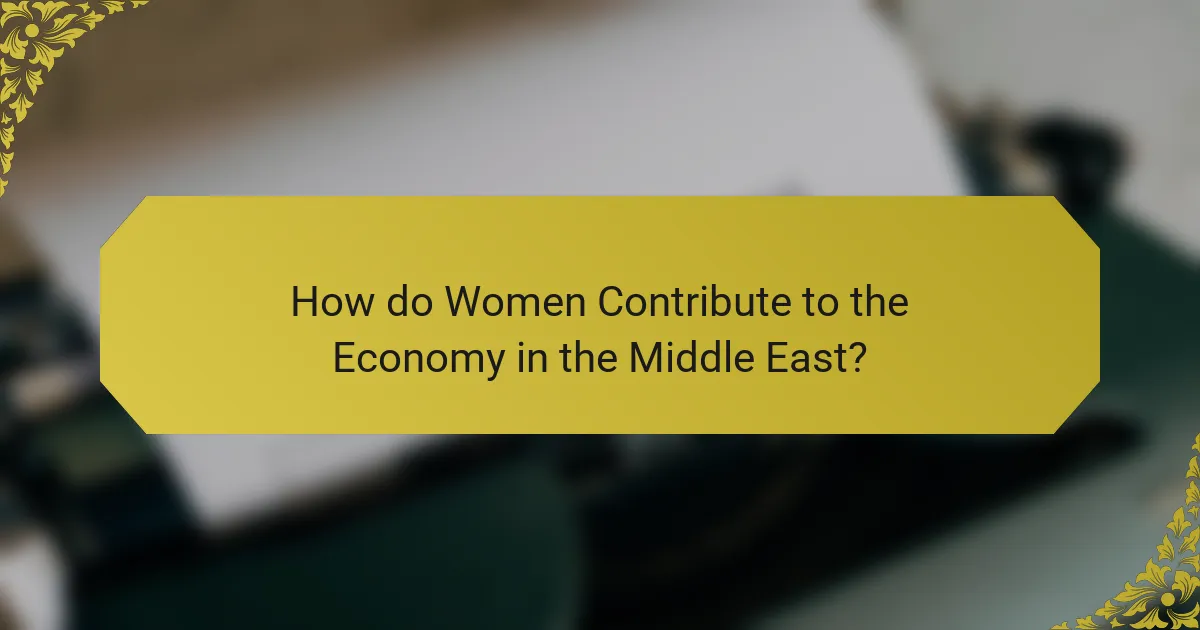
How do Women Contribute to the Economy in the Middle East?
Women contribute to the economy in the Middle East through increased workforce participation and entrepreneurship. Their involvement boosts productivity and innovation in various sectors. For instance, women represent about 22% of the labor force in the region, a figure that is steadily rising. Studies show that increasing female labor force participation could add $600 billion to the region’s GDP by 2025. Additionally, women-owned businesses are growing, with approximately 40% of small and medium enterprises in the region being female-led. This entrepreneurial activity fosters job creation and economic diversification. Furthermore, women contribute to the economy by enhancing family incomes and investing in education and health, which promotes long-term economic stability.
What economic benefits arise from increasing women’s workforce participation?
Increasing women’s workforce participation leads to significant economic benefits. It enhances overall economic growth by increasing the labor supply. More women in the workforce can lead to higher GDP per capita. Research shows that closing gender gaps in labor force participation can boost global GDP by $28 trillion by 2025. Additionally, diverse workforces drive innovation and productivity. Companies with higher female representation often outperform their peers financially. Women’s participation also contributes to improved family incomes and poverty reduction. According to the McKinsey Global Institute, achieving gender parity in the workforce could add $12 trillion to global GDP by 2025.
How does women’s employment impact GDP growth in the region?
Women’s employment positively impacts GDP growth in the region. Increased female participation in the workforce contributes to higher productivity levels. This participation leads to greater economic output and diversification. Studies show that regions with higher women’s employment rates experience faster GDP growth. For instance, the McKinsey Global Institute reported that closing gender gaps in labor force participation could add $28 trillion to global GDP by 2025. Additionally, women’s employment enhances household income and spending, stimulating local economies. Overall, integrating women into the workforce is essential for sustainable economic development in the region.
What role do women play in entrepreneurship within the Middle East?
Women play a significant role in entrepreneurship within the Middle East. They contribute to economic growth and job creation. In recent years, the number of women-owned businesses has increased. Women entrepreneurs often focus on sectors like retail, education, and technology. According to the Global Entrepreneurship Monitor, women’s participation in entrepreneurship in the Middle East is rising. In some countries, such as the UAE, women represent about 30% of entrepreneurs. Challenges remain, including access to funding and societal norms. Despite these challenges, women are increasingly seen as key drivers of innovation. Their contributions are vital for the region’s economic diversification and development.
How can policies support women’s economic contributions?
Policies can support women’s economic contributions by ensuring equal access to education and employment opportunities. For instance, implementing gender quotas in hiring can help increase women’s representation in the workforce. Additionally, providing affordable childcare services enables women to balance work and family responsibilities effectively.
Tax incentives for businesses that promote gender diversity can also encourage the hiring of women. Furthermore, policies that address wage gaps ensure women are compensated fairly for their work.
Research from the McKinsey Global Institute shows that closing gender gaps in labor force participation could add $28 trillion to global GDP by 2025. Thus, supportive policies not only empower women but also drive economic growth.
What initiatives have been successful in promoting gender equality in the workplace?
Successful initiatives promoting gender equality in the workplace include mentorship programs, flexible work arrangements, and diversity training. Mentorship programs connect women with experienced leaders, enhancing career progression. Flexible work arrangements allow for better work-life balance, supporting women’s participation. Diversity training raises awareness of biases and fosters inclusive environments. Research shows companies with gender diversity outperform their peers. According to McKinsey’s “Women in the Workplace 2021” report, organizations with diverse leadership are 25% more likely to outperform their competitors. These initiatives collectively contribute to a more equitable workplace.
How can governments create an environment conducive to women’s employment?
Governments can create an environment conducive to women’s employment by implementing supportive policies and frameworks. These include establishing equal pay legislation to ensure fair compensation. Providing affordable childcare services can enable women to balance work and family responsibilities. Promoting flexible working hours allows women to manage their personal and professional lives more effectively. Additionally, governments can invest in education and training programs tailored for women to enhance their skills. Creating awareness campaigns can challenge societal norms that hinder women’s workforce participation. Implementing anti-discrimination laws protects women from bias in hiring and promotions. Research shows that countries with supportive policies see higher female labor force participation rates, contributing to economic growth. For instance, the World Bank reported that increasing women’s participation in the workforce could boost GDP by up to 34% in some Middle Eastern countries.

What are the Future Prospects for Women in the Middle Eastern Workforce?
The future prospects for women in the Middle Eastern workforce are promising and evolving. Increased government initiatives support women’s employment and leadership roles. For example, Saudi Arabia’s Vision 2030 aims to boost women’s participation to 30% in the workforce. Additionally, the UAE has set a target for women to hold 50% of leadership positions by 2021. Economic diversification efforts in the region create new job opportunities, particularly in sectors like technology and healthcare. Education and training programs are also expanding, equipping women with necessary skills. According to the World Economic Forum, gender parity in the workforce could add $2.7 trillion to the Middle Eastern economy by 2025. These factors indicate a positive trend for women’s roles in the workforce.
How is technology influencing women’s roles in the workforce?
Technology is significantly influencing women’s roles in the workforce by enhancing access to job opportunities and promoting flexible work arrangements. Digital platforms enable women to work remotely, which accommodates family responsibilities. According to a McKinsey report, remote work has led to a 25% increase in female participation in the labor force in some regions. Additionally, technology facilitates skill development through online courses and training programs. This access to education empowers women to pursue careers in traditionally male-dominated fields such as tech and engineering. Furthermore, automation and artificial intelligence are creating new job categories that women can fill. Data shows that women are increasingly represented in digital sectors, contributing to economic growth. Overall, technology is reshaping the workforce landscape, allowing women to play a more significant role in the economy.
What skills will be essential for women to thrive in the future job market?
Essential skills for women to thrive in the future job market include digital literacy, adaptability, and emotional intelligence. Digital literacy allows women to navigate technology and utilize digital tools effectively. Adaptability is crucial as job markets evolve rapidly due to technological advancements. Emotional intelligence helps women manage interpersonal relationships and work collaboratively. Research indicates that 85% of jobs in the future will require skills that are not currently taught in schools, emphasizing the need for continuous learning. Moreover, the World Economic Forum reports that soft skills, including communication and problem-solving, will be increasingly valued. These skills align with the demands of a dynamic workforce, ensuring women can compete and succeed.
How can networking and mentorship programs enhance women’s career advancement?
Networking and mentorship programs enhance women’s career advancement by providing critical support and resources. These programs facilitate connections with industry leaders and peers. Such relationships can lead to job opportunities and promotions. Mentorship offers guidance on career development and skill enhancement. Networking expands professional visibility and access to information. Research indicates that women with mentors are more likely to advance in their careers. A study by Catalyst found that women with mentors earn higher salaries and are more satisfied with their careers. Additionally, these programs foster a sense of community and belonging. This support system is crucial in overcoming workplace challenges faced by women.
What best practices can organizations adopt to support women in the workforce?
Organizations can adopt several best practices to support women in the workforce. Implementing flexible work arrangements can enhance work-life balance for women. Providing mentorship programs helps women develop their careers through guidance and support. Establishing clear policies against discrimination promotes a fair workplace environment. Offering leadership training empowers women to take on managerial roles. Conducting regular pay audits ensures equal compensation for equal work. Creating a supportive network fosters collaboration among women employees. Organizations should also focus on inclusive recruitment practices to attract diverse talent. These practices are essential for enhancing women’s participation and success in the workforce.
How can companies create inclusive workplace environments for women?
Companies can create inclusive workplace environments for women by implementing policies that promote equality and diversity. Providing flexible work arrangements supports work-life balance, which is essential for women. Establishing mentorship programs helps women advance in their careers. Training programs on unconscious bias can educate employees and reduce discrimination. Creating a zero-tolerance policy for harassment fosters a safe environment. Regularly assessing workplace culture through surveys can identify areas for improvement. Companies that prioritize these initiatives see increased employee satisfaction and retention rates. Research from McKinsey & Company indicates that diverse companies are 35% more likely to outperform their peers.
What strategies can be implemented to ensure equal pay for women?
Implementing transparent pay structures is a key strategy to ensure equal pay for women. Organizations should conduct regular pay audits to identify and address disparities. Establishing clear criteria for promotions and raises can help eliminate bias. Providing training on unconscious bias for hiring managers is crucial. Encouraging open discussions about salary among employees can promote transparency. Legal frameworks should be strengthened to support equal pay initiatives. Supporting women’s career advancement through mentorship programs can also be effective. Research shows that companies with pay equity policies see improved employee satisfaction and retention.
The main entity of the article is the role of women in the Middle Eastern workforce, which encompasses their participation, challenges, opportunities, and economic contributions. The article examines the historical evolution of women’s workforce participation, highlighting significant increases in sectors such as healthcare, education, and technology, driven by government initiatives aimed at promoting gender equality. It discusses the cultural and legal barriers that women face, including limited access to leadership roles and societal expectations, while also emphasizing the economic benefits of increasing female labor force participation, which could significantly boost the region’s GDP. Additionally, the article outlines future prospects for women’s employment, the impact of technology, and best practices organizations can adopt to create inclusive environments that support women’s advancement in the workforce.
